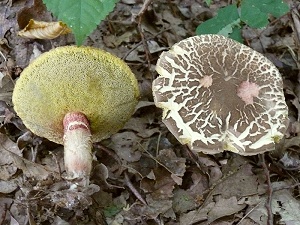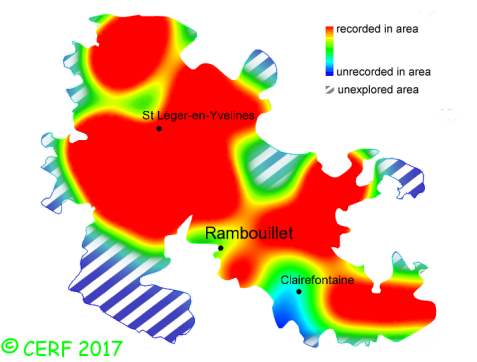| Xerocomus chrysenteron (Bull.) Quél. |
|
|
|
|
|
|
The cap is tawny-olive to reddish brown (particularly in the mountainous regions), with a more or less reddish tinge, fleshy, of a convex then expanded shape, sometimes slightly depressed. The cap surface is matt, dry and never viscid, velvety then smooth, almost always cracking into large patches when drying, showing a reddish tinge of the skin underneath. The cap margin is thick, inrolled and regular. The stem is thin, short, without any network, full and fibrous, of a more or less equal diameter, with a pointy base. It is lemon-yellow with vertical streaks or reddish stains, particularly in the middle or towards the base (it is sometimes entirely red). The base of the stem is buff-white, turning slightly blue when touched.. The flesh is firm at first then quickly soft, whitish to daffodil yellow in the cap, red brown in the stem base. It turns slightly to blue-green when cut and exposed to air, especially above the tubes, then reddens slightly. It is blood-red just underneath the cap surface (typical feature of this species); its taste is faint and mild, sometimes bitterish; the odour is weak, aromatic or of puffball; The tubes are adnate to decurrent through a tooth, easily removed from cap, short (8-14mm). They are pale yellow then olivaceous yellow, turning slightly blue when exposed to air. The pores are rather large (1mm), simple, angular, lemon yellow then olive green to dark brown in the end. They become slightly blue-green when pressed. The spore print is olive brown. It grows in broad-leaved woods, but also with conifers, in parks, gardens, solitary or in troops, at sea level as in the mountains, on a rather acid and damp soil. The fruiting period takes place from May to December.
Chemical tests : no reaction to ammonia. Distinctive features : tawny to brown cap, often cracked when drying; yellow flesh, but red just underneath cap surface; stem streaked with red fibrils; yellow to green pores, turning blue when pressed Xerocomus chrysenteron is frequent and present everywhere in the forest of Rambouillet, and is very frequent, more generally speaking . | ||
|
page updated on 14/01/18

